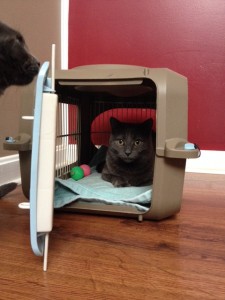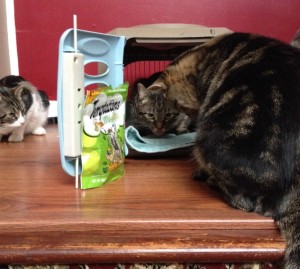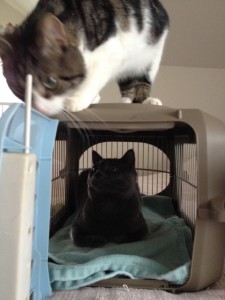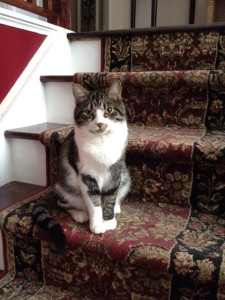
So as part of owning a cat it is inevitable that you will need to travel to the vet from time to time whether it be for annual vaccines, exams, or when Fluffy isn’t feeling well. Does your cat hate his carrier? Think about why this could be…..unlike a dog who gets to go fun places in the car more often than not, the only place Fluffy goes is to the vet’s office. Being the smart feline that Fluffy is, he will likely figure this part of his life out all too quickly. He will therefore manipulate you, therein ‘training’ you as he has now devised a way how not get into his carrier. Using his innate craftiness that I am convinced most, if not all cats possess. Fluffy may simply just go MIA; underground; incognito….not concealing his whereabouts or showing signs that he is around until he is affirmed that you have completely given up on the mission. Surely there are places in your home where Fluffy knows he will be inconspicuous and completely unattainable. Even worse yet, Fluffy may have predicated all out war on you and that “box” thing that you wish to place him in! Ambushing you……perhaps Fluffy resorts to swatting at you or hissing, spitting, and/or biting until veritably, you are now in need a hospital. The auxiliary plan here of course, is to make you exceedingly late, consequently causing irreversible embarrassment squashing your ego as you now have to call your vet’s office and report that you either cannot find your cat, or that you are needing to cancel the appointment as you are now bleeding and in need of a Dr. !
So what now? Well there are some much easier ways to get your cat to the veterinarian and most importantly, maintain the happiness of your delicate Fluffy; and that of your own too, of course. To begin, if you have a kitten….start NOW!!! Make Fluffy’s carrier a fun place to be or even to sleep in! It is essential that it remain part of the furniture in your home for a while, and subsequently here and there after the initial training period. Do not rush anything with your precious Fluffy; he is much smarter than you think.
So to get started off, preferably choose a carrier that is roomy and made of plastic with a door (s). There are so many nice ones to choose from so it will be worth the investment to purchase a nice one. Not to mention, there is no reason to purchase multiple carriers as the kitten grows if you don’t want the expense. This can easily be a one-time investment. Simply ask your veterinarian the approximate size that your Fluffy will become and choose a carrier appropriate for that size. Speaking on behalf of us vet technicians, we really like the ones that have a door at the top also…hint hint. That way you do not have to pull the stubborn or frightened little Fluffy out of the carrier; especially as he gets older and wiser. That said, if you do not feel so inclined to pay for a carrier there are always used ones around, and often times your veterinarian’s office will receive carriers as donations, so it’s always worth asking if they have any! The normal cat carriers are just as practical since you can remove the whole top off with the screws. The soft carriers can be made to work if necessary as well.
Now that you have chosen your carrier, find a central location in your home, your cat’s favorite room, or his dining area to place the carrier. I recommend either taking the door off completely or securing it so there is no risk of it closing accidentally on Fluffy or Heaven forbid his tail or paw. That would make things far more complicated than need be and mentally scar your adored Fluffy. Often times, taking the top of the carrier off can be helpful and entice him to want to play or sleep in his carrier, especially if you have more than one little kitty. Make sure there is nice soft bedding inside and perhaps a favorite toy, treat, or even catnip. It is also said to be helpful to use a pheromone such as Feliway or something of the like, and spray the carrier and bedding with it. Make this a fun place for Fluffy to play in or to get a snack. The one thing you do not want to happen, however, is for Fluffy to mistake the carrier for his bathroom. So if you are still litter box training, it might be advisable to keep the carrier close to his dining area since cats are usually far less inclined to potty in the vicinity of their food. It is imperative that he learn to associate the presence of the carrier with a casual atmosphere and that it isn’t just a dreaded box that only reveals itself when a vet visit is looming.
The next step is to begin to get Fluffy used to the carrier door being closed. It remains imperative that this does not feel like a trap or a punishment to him. Once Fluffy feels overall comfortable with his carrier, place a few treats of his liking inside and then close the door for a few minutes while you are in the room. Perhaps you can watch TV or read to keep him company. Do not leave him alone during this initial door closing experience. After a few minutes open the door and return to your TV or book reading as if it was no big deal. Cats are so intuitive, and feel your emotions so this is why this phase of training needs to be when you are in a quiet and relaxed kind of way. You can incrementally increase the time that Fluffy is enclosed in the carrier, but there is no need to make it too long. It is not a marathon; therefore a short amount of time will suffice. It is more about the positive exposure than the length of time. Once Fluffy seems accustomed to the experience, try to leave the room for a couple minutes and upon your return, give him another treat. If Fluffy is not very food motivated, find a treat that he really likes, or alternatively as mentioned earlier, place the carrier near Fluffy’s dining area. This has proven quite successful for many people. The next step is to repeat the treats and door closure, but then take Fluffy for a little ride in the carrier and walk him about the house. Afterward, place him down, open the door, and give him another treat.
Once Fluffy has graduated these steps, take him for a short car ride. You needn’t go more than around the block or two and then return. For the next week or two indiscriminately take Fluffy on short car rides. Not to the vet’s office. Cats are not like dogs and don’t learn to be happy at the vet for a mere cookie. The hope now is that your beloved Fluffy has achieved acceptance of his new chariot. It is doubtful that he will ‘love’ his new mode of transportation, especially as his veterinary visits become a regular part of life (hopefully just annually). However, the hope is that he will accept it without turning into a ferocious, fractious or unhappy feline. Many cats continue to feel more confident and travel quite well if accustomed to his carrier early on in his life. It may sound like this takes a lot of time to accomplish, but I assure you that it does not. The little amount of time spent on keeping your cat calm and confident in his carrier is time very well spent. When it is time to travel to your next veterinary appointment, remember to calmly use the steps that you have done for a short car ride. You do not want to keep the carrier locked away in some closet only bringing it out when you know you have a veterinary appointment. Your Fluffy will catch on very quick to this, I assure you. Then you are stuck last minute chasing your cat around the home, mostly likely unsuccessfully. The second biggest fail is to come directly toward your cat with a carrier in hand after he hasn’t seen it for a year. If this works for you, congratulations! Consider yourself very fortunate and tell your Fluffy just how special he really is! Moreover, remember the goal here is to make traveling as least stressful as possible so your cat can feel confident and secure.
Maybe you have more than one Fluffy? No worries, it is all the more fun for kitties to have company in their carriers especially if they are litter-mates, good friends, or are or near in age. Remember it is important to keep up positive experiences between your cat carrier and your kitty. So just because he’s aged it doesn’t mean that you do not need to keep up a little work now and again. Imagine if you only got in the car to go to the Dr.’s office and that was the only place you ever went? I highly doubt that you would like the car. Fortunately, animals are a bit more forgiving and trusting than humans can be.
Maybe you have an older or adopted cat and he doesn’t like his carrier at all, or Fluffy is already at the point where he has out-witted and out smarted you. Or perhaps he is already giving you battle scars making it not worth your while to even try to take him to the veterinarian. We will elaborate on some more ideas in another blog on these more difficult, or complicated felines. We can discuss traveling with your cat long distances in the instance that you are moving or whatever the case might be.
Remember to leave any suggestions for future blogs or to share what has worked for you in the comment section!
Happy Tails and Safe travels!
~Stefany Wolfe





